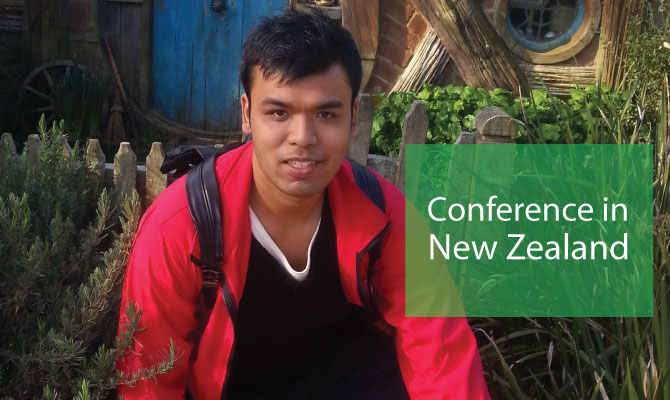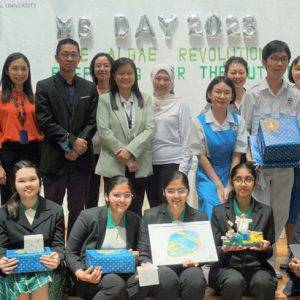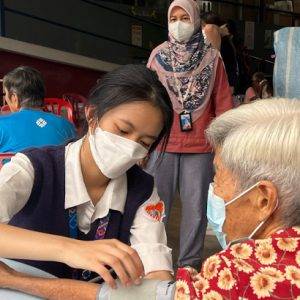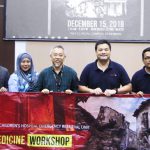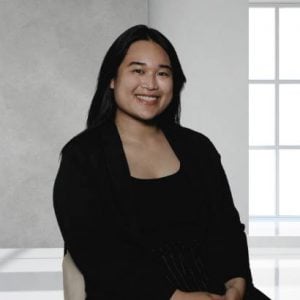An International Medical University (IMU) Medical Biotechnology final year student, Foo Keat Hong presented his final year project outcomes at the 33rd Australasian Winter Conference on Brain Research (AWCBR). This conference was supported by the Neurological Foundation of New Zealand and held from 29 August 2015 to 2 September 2015 at the Copthorne Resort Hotel, Queenstown, New Zealand.  This conference emphasised on neuroscience-related research and was well attended by scientists and clinicians who worked on similar areas of interest. About 200 experts from various institutions such as Washington University, University of California, University of Otago, Terukayama University etc were involved in delivering plenary lectures, oral and poster presentations. Foo was thankful to be granted such a valuable opportunity to attend this international conference. This 5-day conference was filled with informative plenary lectures and keynote speeches by world-leading neuroscientists on their current research. They have enlightened him with the latest neuroscience discoveries, as well as their professional scientific presentation skills.
This conference emphasised on neuroscience-related research and was well attended by scientists and clinicians who worked on similar areas of interest. About 200 experts from various institutions such as Washington University, University of California, University of Otago, Terukayama University etc were involved in delivering plenary lectures, oral and poster presentations. Foo was thankful to be granted such a valuable opportunity to attend this international conference. This 5-day conference was filled with informative plenary lectures and keynote speeches by world-leading neuroscientists on their current research. They have enlightened him with the latest neuroscience discoveries, as well as their professional scientific presentation skills.
“Scientific communication is very important in both written and oral forms, especially when delivering the information professionally. Besides gaining latest neurosciences related information, I also learnt the way the researchers presented their research outcomes. This experience would be very useful for me in the future as I plan to further my studies to Master and PhD levels. What impressed me the most was that the speakers were able to capture the audience’s attention and some even included the neuroscience jokes in their talks”, said the young student.
 He further reflected that the plenary lecture on “Deciphering Brain Connectivity and Function with Rabies Virus and Light” by Prof Ed Callaway, from Salk University, USA has particularly gained his attention because the study provided a new insight to neuroscience by using the recombinant rabies virus system to understand the connection within the brain region, decode the mechanism of brain function upon the defect of the connection. The outcomes of this study would definitely bring brain related research to the next level through better understanding of underlying mechanisms in neurological diseases. Foo also noted that both oral and poster presentations in this conference were mainly participated by postgraduate students, who would like to showcase their research outcomes. Nevertheless, as an undergraduate student, Foo was given the opportunity to present his poster entitled “Neuroprotection role of Centella asiatica extract on hydrogen peroxide-induced SH-SY5Y cells” on 31 August 2015.
He further reflected that the plenary lecture on “Deciphering Brain Connectivity and Function with Rabies Virus and Light” by Prof Ed Callaway, from Salk University, USA has particularly gained his attention because the study provided a new insight to neuroscience by using the recombinant rabies virus system to understand the connection within the brain region, decode the mechanism of brain function upon the defect of the connection. The outcomes of this study would definitely bring brain related research to the next level through better understanding of underlying mechanisms in neurological diseases. Foo also noted that both oral and poster presentations in this conference were mainly participated by postgraduate students, who would like to showcase their research outcomes. Nevertheless, as an undergraduate student, Foo was given the opportunity to present his poster entitled “Neuroprotection role of Centella asiatica extract on hydrogen peroxide-induced SH-SY5Y cells” on 31 August 2015.
Feeling proud, he mentioned “I realised that most of the presenters were either postgraduate students or neuroscience researchers. As an undergraduate student, this was a great moment for me to communicate with them, to inquire the findings of their research projects and most importantly, to enhance my research interest as well as to stimulate more research ideas on neuroscience. Some scientists has shown a deep interest in my research findings too. I am glad to be able to share my research outcomes with them while learning from them as well as to establish the possible collaboration in the future.”
Besides gaining new information on neuroscience related research, attending an international conference and the social programme arranged by the organiser allowed him to further interact with scientists from various countries, as well as understand their cultures. He had the opportunity to attend the welcome reception at skyline gondola of Queenstown. In addition to the welcome reception, Foo was amazed by the marvellous scenery of New Zealand and explored the beauty of Queennstown Park through the sight-seeing programme arranged by the organiser. For example, a trip to Hobbiton to visit the film site for the ‘Lord of the Ring and The Hobbit’ movie has really impressed him.  “Masatoshi Yamashita and I explored the beauty of Queenstown Park during the sight-seeing programme. Masatoshi is a PhD student from Tezukayama University, Japan. Since English is not his native language, I was helping him throughout the conference, especially in explaining some of the terms to him in simple English. By peer-pairing with Masatoshi, I have learnt how to communicate and helped peer who face language barrier.” He added that “I felt very lucky that throughout my three years in IMU, I have been well-trained to be conversant in English.” “I would like to express my greatest appreciation to my parents and IMU for providing the financial support to attend the AWCBR conference. Additionally, I would like to thank my supervisors Dr Anna Ling Pick Kiong, Dr Koh Rhun Yian and Miss Wong Ying Pei for their professional guidance and support throughout my final year project. Without them, I would not have the chance to explore this informative and valuable conference. This experience is very important and fruitful especially in knowing the latest research findings, networking as well as for personal development”, he said.
“Masatoshi Yamashita and I explored the beauty of Queenstown Park during the sight-seeing programme. Masatoshi is a PhD student from Tezukayama University, Japan. Since English is not his native language, I was helping him throughout the conference, especially in explaining some of the terms to him in simple English. By peer-pairing with Masatoshi, I have learnt how to communicate and helped peer who face language barrier.” He added that “I felt very lucky that throughout my three years in IMU, I have been well-trained to be conversant in English.” “I would like to express my greatest appreciation to my parents and IMU for providing the financial support to attend the AWCBR conference. Additionally, I would like to thank my supervisors Dr Anna Ling Pick Kiong, Dr Koh Rhun Yian and Miss Wong Ying Pei for their professional guidance and support throughout my final year project. Without them, I would not have the chance to explore this informative and valuable conference. This experience is very important and fruitful especially in knowing the latest research findings, networking as well as for personal development”, he said.




